Starting a Starter
The thing about starters is, they’re incredibly easy. If they weren’t, human beings would never have invented bread. The only trick is remembering to care for it. The vast majority of starter failures come from forgetting to feed one on a regular basis. If you can do that you won’t have any problems.
Begin a starter by creating a mixture of 50% flour and 50% water (by weight), say two ounces of each. Stir.

What you’ll get is something that looks like pancake batter.
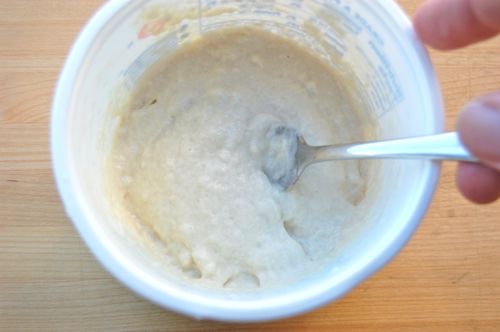
All you do now is set a piece of paper towel on top of the container and let it sit for two days. After which time you may be surprised to see not much happening. Mine looked about like so:
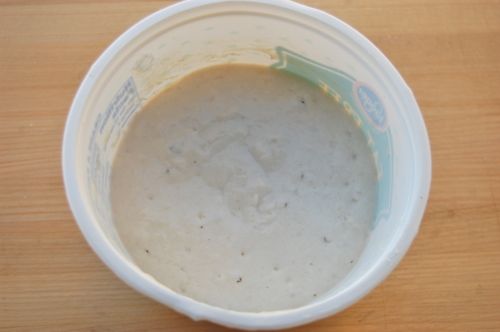
Not much going on but a few bubbles. However the yeast were working in there, as you’ll see. The best way to tell if it’s active is to smell it. It should smell at least a little pungent…like sourdough bread.
Having gotten the beginnings of a yeast culture going, it’s time to start feeding it. This is done by “refreshing” your starter with that same 50-50 (by weight) flour-water mixture that you began with. You want to put in at least as much fresh “food” as you have starter.
So, starting with a fresh container, put in two ounces of the culture you’ve initiated (pitch the rest)…
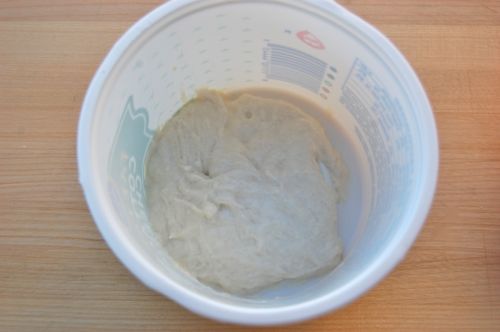
plus 1 ounce of flour…
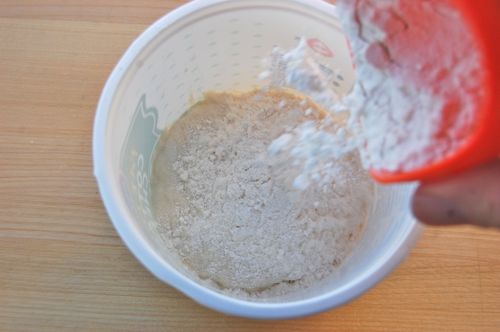
…and 1 ounce of water.

And stir it up. Over the next few days you’ll feed the starter once per day doing the same thing: separating out two ounces of starter and discarding the rest (lest your starter take over your house) and feeding it with two ounces of flour-water mix.
You should see a big change in the amount of activity, by which I mean a radical growth-and-contraction of the mixture each night. Here’s what mine looked like on the second day of regular feedings (day 4). It expanded about three quarters of the way up the side of the container.

That’s quite a big expansion from a scant four ounces of mix. This might be a full strength, rarin’-to-go starter of the kind you can bake with or maybe not. It’s possible that it’s a Clostridium perfringens culture which can make a person quite sick. So I check the smell — does it smell like bread? Or more like garbage (or vomit)? I’m not sure so I wait for a full six or seven days before I use it, just to make sure I’ve cleared out all the suckers (i.e. potentially harmful bacteria).
This is what the starter typically looks like in the morning once it’s exhausted its food supply: collapsed.
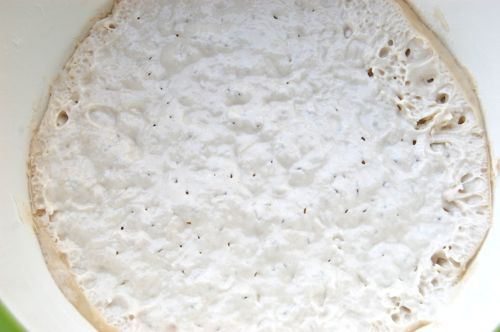
What’s happening here is that the yeast have reached their peak population and lacking any more fuel to keep growing are lapsing into a kind of semi-dormancy. A starter that looks like this should still, however, be considered a full-strength leavener. It will remain so, refrigerated, for up to three days.
Having created a starter, you can simply keep it out all the time, refreshing it nightly. That, however, can get tiresome unless you’re using one several times each week. The way to store it is to give it a fresh infusion of food, let it sit for half an hour or so, then put it in the fridge. Fed a minimum of once a week, it’ll stay active indefinitely. I generally keep the same eight- or twellve-ounce quantity in the fridge, since it doesn’t take much to feed and I know I can build it up to whatever I need in one or two days’ time.
What to do if you have more starter than you need? Make sourdough pancakes, sourdough fritters or sourdough onions rings. There are recipes for all of them on the site under Bread, Pastry and Totally Not Pastry respectively.
Hi Joe! First of all I want to publicly admit that I totally, completely fell in love with your website/ blog. It’s been days since I spend almost all my free time reading your posts, recipes, tricks and other goodies – a huge thank you for everything you’re doing here!
And given the fact that Christmas is coming and that I really like panettone, I would love to make one myself. The problem – well, at this point at least! LOL – is that reading about starters and dough and breads and everything, now I am completely lost. In your post about how to start a starter 🙂 , you mention mixing flour and water and letting them sit and do their thing and all, and then you say that the yeast is working and doing its job… But I can’t find where you’re saying how much yeast you add to the water/ flour mixture (actually I can’t find any mention about adding yeast). Help, please!
Hey Loana!
There I’m referring to the wild yeast that’s already in there. It’s in the flour…just a little. By making a starter you’re encouraging it to grow. Does that make sense?
Cheers,
– Joe
Well… it kind of was the obvious answer, but I couldn’t really convince myself that the flour I’ve been using for years has yeast in it and I had no idea! 🙂 Thank you, I think I’ll give it a try – you make it all sound so easy!
Sorry I spelled your name wrong, Ioana! But yes, wild yeast grows on the outside of wheat berries in the field. There’s no way to get rid of it, so it’s just ground into the flour. It doesn’t do much unless you wet it and encourage it to grow by leaving it out at room temperature. Have fun making the starter and get back to me if you have any questions!
– Joe
Hey Joe!
Today is the second day of feeding the starter (actually the day has just begun, so no food for the starter yet). Nothing happens from what I can see, apart a slight specific smell. I’ll see what happens by tomorrow and then I’ll switch to the “2 meals/day” schedule if I see no activity. I have some questions, though (I almost wrote dough, lol): first, should I put it in a room that’s warmer? I keep the temperature in my house at 22-23 degrees Celsius – is that enough? And second, the starter is covered by a crust – is that ok or maybe I should cover it with cling film or … what? It’s really dry here in Montreal during the winter and even with the humidifier and the fish tank and whatever else, I know the air is dry. Any thoughts?
Thanks,
Ioana
Hi Ioana!
You’ll want to put some plastic wrap on that, and press it to the surface so you don’t get that crust. Just let it go for a few days at one feeding per day. Be patient. These things take time. 22-23 is just fine. It might take a full week or so. You’ll know it’s taking off when you get lots of bubbles overnight.
Just ignore it and it’ll do fine! Cheers,
– Joe
Hello Mr. Pastry!
I tried out your Danish dough recipe (amazing!), I’ve got a batch of your croissant dough in the refrigerator for fresh pain au chocolat in the morning, and now I’m eyeing your sourdough recipes.
Question about overall time frame here:
Day 1: leave starter out at room temp.
Day 2: same as 1.
Day 3: remove 2 ounces, add one ounce water mixed with one ounce flour.
Day 4: same as 3.
From here, you recommend waiting 6-7 days.
Are you feeding the starter every day as in days 3&4?
Is the 6-7 days in addition to the 4 days to get a full-strength leavener (making the starter making process a 10-11 day process?
Thanks for your labor of love! I feel like I’m working towards a Joe Pastry merit badge!
Hey Fil!
Yes, after a couple of days to encourage some yeast growth I basically suggest feeding your flour slurry once a day — 100% of its weight — for as many days as it takes to get it very, very bubbly. That’s really all it takes. Just make sure it smells like bread and not, er…vomit, which means clostridium perfringens, something you don’t want. If that happens just keep going with the program (making sure to wash all your implements and not ingest any of the bad stuff) until the yeast naturally out-competes that initial culture. It’s really a very simple process!
Cheers and get back to me with any questions!
– Joe
It’s me again, Mr. Pastry.
Here’s my question. So after you go through the 7-10 day process of making the sourdough, you’ll end up with 4 oz of starter (assuming you discard all but 2 oz of starter and add 1 oz each of flour and water).
You want to make a a batch of sourdough pancakes, which calls for 2 C of starter, left out overnight. How do you get this 2 C to bake with while leaving enough starter to propagate on its own?
Thanks!
*assuming you discard all but 2 oz of the starter and add 1 oz each of water and flour at every feeding…
Hi Joe,
Now that I’m such good friends with the starter 🙂 and that I planned and managed to have some left after making the panettones (they’re rising right now, I can barely wait to see the final result!), I tried to find a recipe for sourdough bread on your blog in order to put that starter to another good use – but I couldn’t find such a recipe. Is it just me or it really isn’t one here?
Thank you,
Ioana
Hello Ioana!
I don’t have anything specifically called “sourdough” since my start isn’t especially “sour” however several of the breads call for starter. Check the Pugliese, the English muffins, pancakes, even the focaccia can be converted to start (decrease the recipe by 1/3 and replace that amount of dough with starter). The possibilities are just about endless!
– Joe